Working out rates
Every freelancer has to work out a rate. But how do you work it out?
There are lots of things to consider:
- Your experience
- Costs and expenses
- The services on offer
- Pensions
- Savings
- How much you can work
- Target client
- Childcare
- The market
Whatever method of billing you choose, you’ll at least need to charge enough to cover your costs, time and a little bit of profit. Beyond this, it’s up to you what you charge – it’s completely up to you.
Most freelancers return to this topic at least a couple of times during their career. As their experience increases or their services change, rate increases are a natural next step.
Some freelancers state an annual increase of a few percent to make sure their pay increases above inflatio
Working out a rate #
Calculating a rate unavoidable means doing a little bit of maths. I’m very sorry about that.
It’s a complex and nuanced topic that deserves more detail than we can afford it here. There are some resources at the end of this page, but as a starting point you’ll need to work out what you need to make to get by.
First, you’ll need to work out every single expense you have:
- Rent or mortgage
- Insurance
- Software subscriptions
- Office or work from home expenses (office rent, gas, electricity, internet, phone)
- Equipment
- Travel
- Marketing (website, domain, hosting, maintenance, any other marketing materials or expenses)
- Childcare
You might also want to consider:
- Pension
- Personal savings
- Medical insurance
Then you’ll want to consider other day-to-day and personal expenses (e.g. food!).
Once you’ve added these up, round them up a bit and make it into an annual figure (i.e. multiply the expenses by 12 if you’ve worked them out on a monthly basis). You’ll then have a rough idea of what you need to make annually to keep yourself afloat.
Example #
Let’s say you work out you need £30,000 to get by each year and cover all of your expenses. £30,000 ÷ 52 = £577 per week, right?
That’s mathematically correct, but it’s the wrong calculation.
You’ll need to work out how much time you want or are likely to take off per year, including time off for illness. Let’s say you take 30 days holiday (6 working weeks) plus one week of sick leave.
That leaves 45 weeks of the year: £30,000 ÷ 45 = £666.67 per week. That’s roughly £134 per day.
If we divide this by 8 we get an hourly rate of £16.75. But here’s the thing: many freelancers expect to bill no more than 50% of their hours to account for marketing, admin and other non-billable time.
That’s 20 hours per week or 4 hours per day.
That means the calcuation to get our real hourly rate might be closer to this:
£134 ÷ 4 = £33.50 per hour
Bear in mind that this rate is the minimum you would need to charge to cover costs.
Also, be aware that his example is flawed and simplified for the purposes of brevity:
- The £30,000 figure includes expenses: if you wanted a take-home pay of £30,000, the turnover would need to be much higher
- We haven’t properly considered pension, savings, tax or other costs
- You may want to account for more time off
Resources #
This section of the guide is sponsored by the Work Notes Freelance Pricing Guide. The guide looks in-depth at working out a practical minimum rate, whatever your situation.
There are lots of other resources out there, including:
- Jessica Hische’s Dark Art of Pricing
- Jonathan Stark’s Hourly Billing Is Nuts
- Chris Voss’s Never Split The Difference: not a book on rates per se, but useful on negotiation
- Creative Bloq article on working out a shop rate
Money sponsor

The Freelance Pricing Guide
The Work Notes Freelance Pricing Guide has helped 400 freelancers set rates than work for them.
